Students can Download Tamil Nadu 11th Economics Model Question Paper 2 English Medium Pdf, Tamil Nadu 11th Economics Model Question Papers helps you to revise the complete Tamilnadu State Board New Syllabus and score more marks in your examinations.
TN State Board 11th Economics Model Question Paper 2 English Medium
Instructions:
- The question paper comprises of four parts.
- You are to attempt all the parts. An internal choice of questions is provided wherever applicable.
- questions of Part I, II. III and IV are to be attempted separately
- Question numbers 1 to 20 in Part I are objective type questions of one -mark each. These are to be answered by choosing the most suitable answer from the given four alternatives and writing the option code and the corresponding answer
- Question numbers 21 to 30 in Part II are two-marks questions. These are to be answered in about one or two sentences.
- Question numbers 31 to 40 in Parr III are three-marks questions, These are to be answered in about three to five short sentences.
- Question numbers 41 to 47 in Part IV are five-marks questions. These are to be answered) in detail. Draw diagrams wherever necessary.
Time: 3 Hours
Maximum Marks: 90
Part – I
Choose the correct answer. Answer all the questions: [20 × 1 = 20]
Question 1.
The process of reasoning from particular to general is ………………….
(a) Deductive method
(b) Inductive method
(c) Positive Economics
(d) Normative Economics
Answer:
(b) Inductive method
![]()
Question 2.
The relationship between the price of a commodity and the supply of commodity is ………………….
(a) negative
(b) positive
(c) zero
(d) increase
Answer:
(b) positive
Question 3.
Growth definition takes into account:
(a) The problem of choice in the dynamic frame work of Economics
(b) The problem of unlimited means in relation to wants
(c) The production and distribution of wealth
(d) The material welfare of human beings.
Answer:
(a) The problem of choice in the dynamic frame work of Economics
![]()
Question 4.
Primary Institution is ………………….
(a) village
(b) cities
(c) both a & b
(d) urban
Answer:
(a) village
Question 5.
Density of population = ………………….
(a) Land area / Total Population
(b) Land area / Employment
(c) Total Population / Land area of the region
(d) Total Population / Employment
Answer:
(c) Total Population / Land area of the region
Question 6.
The Planning Commission was setup in the year ………………….
(a)1950
(b)1955
(c)1960
(d) 1952
Answer:
(a)1950
Question 7.
The arrival of Vasco-da Gama in Calicut, India ………………….
(a) 1498
(b) 1948
(c) 1689
(d) 1849
Answer:
(a) 1498
![]()
Question 8.
If x + y = 5, x – y = 3 then value of x = ………………….
(a) 4
(b) 3
(c) 16
(d) 8
Answer:
(a) 4
Question 9.
The first known writer to apply mathematical method to economic problems was ………………….
(a) Cramer
(b) William Petty
(c) Giovanni Ceva
(d) Italian
Answer:
(c) Giovanni Ceva
Question 10.
Another name of price is ………………….
(a) Average Revenue
(b) Marginal Revenue
(c) Total Revenue
(d) Average cost
Answer:
(a) Average Revenue
Question 11.
Micro Economics is concerned with ………………….
(a) the economy as a whole
(b) different sectors of an economy
(c) the study of individual economic units behaviour
(d) the interactions with in the entire economy
Answer:
(c) the study of individual economic units behaviour
Question 12.
“ An Indian farmer is bom in debt, lives in debt, dies in debt and bequeaths debt”-who said this?
(a) Adam Smith
(b) Gandhi
(c) Amartya Sen
(d) Sir Malcolm Darling
Answer:
(d) Sir Malcolm Darling
![]()
Question 13.
Formula for calculating AP is ………………….
(a) ∆TP/N
(b) ∆TP/AN
(c) TP/MP
(d) TP/N
Answer:
(d) TP/N
Question 14.
Identify the year of launch of MUDRA Bank?
(a) 1995
(b) 2000
(c)2010
(d) 2015
Answer:
(d) 2015
Question 15.
Identify the cause for rural indebtedness in India.
(a) Poverty
(b) High population
(c) High productivity
(d) Full employment
Answer:
(a) Poverty
Question 16.
The indifference are ………………….
(a) vertical
(b) horizontal
(c) positive sloped
(d) negatively sloped
Answer:
(d) negatively sloped
Question 17.
The functional relationship between “inputs” and “outputs” is called as ………………….
(a) Consumption Function
(b) Production Function
(c) Savings Function
(d) Investment Function
Answer:
(b) Production Function
Question 18.
Identify the agriculture related problem of rural economy.
(a) Poor communication
(b) Small size of landholding
(c) Rural poverty
(d) Poor banking network
Answer:
(b) Small size of landholding
![]()
Question 19.
The primary factors of production are ………………….
(a) labour and organisation
(b) labour and capital
(c) Land and capital
(d) land and labour
Answer:
(d) land and labour
Question 20.
Profit is the reward for ………………….
(a) land
(b) organization
(c) capital
(d) labour
Answer:
(b) organization
Part – II
Answer any seven question in which Question No. 30 is compulsory. [7 × 2 = 14]
Question 21.
Name any two types of utility.
Answer:
- Time Utility: A sick man derives time utility from blood not at the time of its donation, but only at the operation-time, i.e., when it is used.
- Place Utility: A student derives place utility from a book not at the place of its publication (production centre) but only at the place of his education (consumption centre).
Question 22.
State the meaning of Special Economic Zones.
Answer:
- The Special Economic Zones [SEZs] policy was announced in April 2000.
- As per the Special Economic Zones Act of 2005, the government has so far notified about 400 such zones in the country.
- The SEZ deprives the farmers of their land and livelihood, it is harmful to agriculture.
- To promote export and Industrial growth in line with globalization the SEZ was introduced in many countries.
Question 23.
Distinguish between real and money wages.
Answer:
Money Wages :
- Money wages are referred to the wages paid in terms of money.
- Depend upon the standard of living workers in a country.
Real Wages :
- Real wages are the wages paid in terms of goods and services.
- Depend upon the purchasing power of money.
Question 24.
Define GSDP.
Answer:
- The Gross State Domestic Product refers to the total money value of all the goods and services produced annually in the state.
- Tamil Nadu is the second largest economy in India with a GSDP of $ 207.8 billion in 2016-2017 according to the Directorate of Economics and Statistics, Tamil Nadu.
Question 25.
What is the heritage tourism?
Answer:
- Tamil Nadu has since ancient past been a hub for tourism.
- In recent years, the state has emerged as one of the leading tourist destinations for both domestic and foreign tourists.
- Tourism in Tamil Nadu is promoted by Tamil Nadu Tourism Development Corporation (TTDC), a Government of Tamil Nadu undertaking.
- The State currently ranks the highest among Indian States with about 25 crore arrivals (in 2013). Approximately 28 lakh foreign and 11 crore domestic tourists visit the state.
Question 26.
Classify the factors of production.
(a) Land (b) Labour (c) Capital and (d) Organisation
Answer:
(a) Land: In Economics, land means all gifts of Nature owned and controlled by human beings which yield an income.
(b) Labour: Labour means manual labour or unskilled work.
(c) Capital: “Capital consists of all kinds of wealth other than free gifts of nature, which yield income”. Bohm-Bawerk defines it as ‘a produced means of production’.
(d) Organisation: The man behind organizing the business is called as ‘Organizer’ or ‘Entrepreneur’.
Question 27.
What do you mean by Micro Finance?
Answer:
- Micro Finance also known as Micro credit is a financial service that offers loans, savings and insurance to entrepreneurs and small business owners who do not have access to traditional sources of capital like banks or investors.
- The goal of micro financing is to provide individuals with money to invest in themselves or their business.
- Micro finance is available through micro finance institutions, which range from small non-profit organisations to larger banks.
![]()
Question 28.
Define Cost.
Answer:
Cost refers to the total expenses incurred in the production of a commodity. Cost analysis refers to the study of beheriour of cost in relation to one or more production criteria namely size of output, scale of production prices of factors and other economic variables.
Question 29.
What are the major ports in Tamil Nadu?
Answer:
- Tamil Nadu has three major ports; one each at Chennai, Ennore, and Thoothkudi as well as one intermediate port in Nagpattinam, and 23 minor ports.
- All the minor ports are managed by the Tamil Nadu Maritime Board, Chennai Port.
- Ennore port was recently converted from an intermediate port to a major port and handles all the coal and ore traffic in Tamil Nadu.
Question 30.
Define Micro Industry.
Answer:
- Micro, small and medium Enterprises are MSMEs produce a wide variety of products in almost all sectors.
- The prominent among them are the engineering, electrical, chemicals, plastics, steel, paper, matches, textiles, hosiery and garments sector.
Part – III
Answer any seven question in which Question No. 40 is compulsory. [7 × 3 = 21]
Question 31.
What is GST advantages?
Answer:
- GST – Goods and Services Tax. GST is defined as the tax levied when a consumer buys a good or service.
- Removing cascading tax effect
- Single point tax
- Higher threshold for registration
- Composition scheme for small business
- Online simpler procedure under GST
- Defined treatment for e-commerce .
- Increased efficiency in logistics .
- Regulating the unorganized sector
![]()
Question 32.
Mention the Functions of APMC.
Answer:
The Agriculture Produce Market Committee [APMC] Act 2003, the Agricultural Produce Market Committee [AMPC] is a statutory body constituted by State Government in order to trade in agricultural or horticultural or livestock products.
Functions of APMC:
- To promote public private partnership in the ambit of agricultural markets.
- To provide market led extension services to farmer.
- To bring transparency in pricing system and transactions taking place in market in a transparent manner.
- To ensure payments to the farmers for the sale of agricultural produce on the same day.
- To promote agricultural activities. ‘
- To display data on arrivals and rates of agricultural produce from time to time into the market.
Question 33.
Define Economic Development.
Answer:
- The economic development is indicated not just by GDP, but by an increase in citizen’s quality of life or well being.
- The quality of life is being assessed by several indices such as Human Developments Index [HDI]
- On the basis of the level of economic development, nations are classified as developed and developing economies.
- Developed economies are those countries which are industrialized.
- Developments economics are also termed as advanced countries.
- On the other hand, countries which have not fully utilized their resources like land, mines, workers, etc. and have low per capita income are termed as under developed economics.
Question 34.
Explain the prospect for development of tourism.
Answer:
- Tourism in Tamil Nadu is promoted by Tamil Nadu Tourism Development Corporation (TTDC), a Government of Tamil Nadu undertaking.
- Tamil Nadu has since ancient past been a hub for tourism. In recent years, the state has emerged as one of the leading tourist destinations for both domestic and foreign tourists.
- The state currently ranks the highest among Indian states with about 25 crore arrivals in 2013.
- Approximately 28 lakh foreign and 11 crore domestic tourists visit the State.
Tourist arrival in India 2016
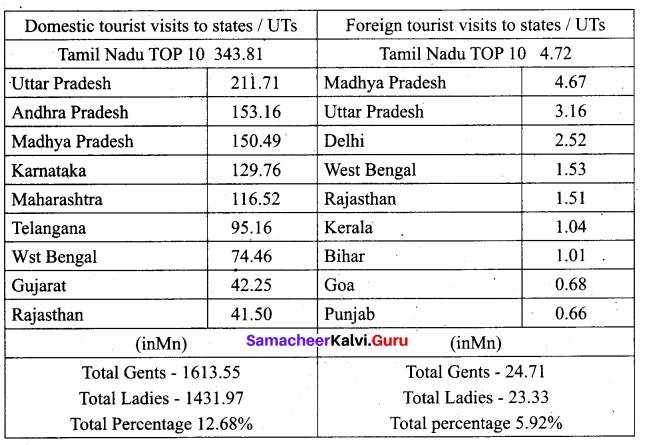
Question 35.
Mention the relationship between marginal utility and total utility.
Answer:
Marginal utility :
- Marginal utility goes-on diminishing.
- Marginal utility becomes zero.
- Marginal utility becomes negative.
Total utility:
- Total utility goes on Increasing.
- Total utility maximum.
- Total utility diminishes.
![]()
Question 36.
Illustrate the uses of Mathematical Methods in Economics.
Answer:
Uses of Mathematical Methods in Economics:
- Mathematical Methods help to present the economic problems in a more precise form.
- Mathematical Methods help to explain economic concepts.
- Mathematical Methods help to use a large number of variables in economic analyses.
- Mathematical Methods help to quantity the impact dr effect of any economic activity implemented by Government or anybody. There are of course many other uses.
Question 37.
State the features of Duopoly.
Answer:
- Each seller is fully aware of his rival’s motive and actions.
- Both sellers may collude, (they agree on all matters regarding the sale of the commodity).
- They may enter into cut-throat competition.
- There is no perfect differentiation.
- They fix the price for their product with a view to maximising their profit.
Question 38.
State Ambedkar’s Economic ideas on agricultural economics.
Answer:
In the 1918, Ambedkar published a paper “Small Holding in India and their Remedies”. Citing Adam Smith’s “Wealth of Nations”, he made a fine distinction between “Consolidation of Holdings” and Enlargement of Holdings”.
Question 39.
Write the VKRV Rao’s contribution on multiplier concept.
Answer:
- VKRV Rao’s examination of the “Interrelation between investment, income and multiplier is an under developed economy” [1952] was his major contribution to macroeconofnic theory.
- Asa thinker, teacher, economic adviser and direct policy maker, VKRV Rao followed the footstep of his great teacher, John Maynard Keynes.
Question 40.
Solve for x quantity demanded if 16x – 4 = 68 + 7x.
Answer:
16x – 4 = 68 + 7x
16x – 7x = 68 + 4
9x = 72
x = 72/9
.’. x = 8
![]()
Part – IV
Answer all the questions. [7 × 5 = 35]
Question 41.
(a) Explain the objectives and characteristics of SEZs.
Answer:
- The Special Economic Zones [SEZs] Policy was announced in April 2000.
- The Special Economic Zones Act of 2005, the government has so far notified about 400 such zones in the country.
Major objectives of SEZs:
- To enhance foreign investment, especially to attract foreign direct investment [FDI] and thereby increasing GDP.
- To increase shares in Global Export. (International Business) ‘
- To generate additional economic activity.
- To create employment opportunities.
- To develop infrastructure facilities.
- To exchange technology in the global market.
Main Characteristics of SEZ:
- Geographically demarked area with physical security.
- Administrated by single body authority.
- Streamlined procedures.
- Having separate custom area.
- Governed by more liberal economic laws.
- Greater freedom to the firms located in SEZs.
[OR]
(b) The features of Rural Economy are peculiar – Argue.
Answer:
Features of Rural Economy:
- Village is an Institution: The village is a Primary Institution and it satisfies almost all the needs of the rural community. The rural people have a feeling of belongingness and a sense of unity towards each other.
- Dependence on Agriculture: The rural economy depends much on nature and agricultural
activities. Agriculture and allied activities are the main occupation in rural areas. - Life of Rural people: Lifestyles in villages are very simple. Public services like education, housing, health and sanitation, transport and communication, banking, roads and markets are limited and unavailable. The standards of living of majority of rural people are poor and pitiable. In terms of methods of production, social organization and political mobilization, rural sector is extremely backward and weak.
- Population Density: Population density, measured by number of persons living per sq.km is very low and houses are scattered in the entire villages.
- Employment: There exists unemployment, seasonal unemployment and under employment in rural areas.
- Poverty: Poverty is a condition where the basic needs of the people like food, clothing and shelter are not being met.
- Indebtedness: People in rural areas are highly indebted owing to poverty and underemployment, lack of farm and non – farm employment opportunities, low wage employment, seasonality in production, poor marketing network etc.
- Rural Income: The Income of the rural people is constrained as the rural economy is not sufficiently vibrant to provide them.
- Dependency: Rural households are largely dependent on social grants and remittances from family members working in urban areas and cities.
- Dualism: Dualism means the co-existence of two extremely different features like developed and under developed. These characteristics are very common in rural areas.
- Inequality: The distributions of income, wealth and assets are highly skewed among rural people. Land, livestock and other assets are owned by a few people.
- Migration: Rural people are forced to migrate from villages to urban areas in order to seek gainful employment for their livelihood.
![]()
Question 42.
(a) What are the characteristics of labour?
Answer:
- Labour is the animate factor of production.
- Labour is an active factor of production.
- Labour implies several types. It may be manual [farmer] or intellectual [teacher, lawyer etc]
- Labour is perishable.
- Labour is inseparable from the labourer.
- Labour is less mobile between places and occupations.
- Labour is a means as well as an end. It is both the cause of production and consumer of the product.
- Labour units are heterogeneous.
- Labour differs in ability.
- Labour – supply determines its reward [wage]
- Labour has weak bargaining power.
[OR]
(b) Explain the Keynesian theory of Interest.
Answer:
- Keynes’ Liquidity Preference Theory of Interest or The monetary Theory of Interest
- Keynes propounded the Liquidity Preference Theory of Interest in his famous book,
“ The General Theory of Employment, Interest and Money “in 1936. - According to Keynes, interest is purely a monetary phenomenon because the rate of interest is calculated in terms of money.
- “Interest is the reward for parting with liquidity for a specified period of time”.
Meaning of Liquidity Preference:
- Liquidity preference means the preference of the people to hold wealth in the form of liquid cash rather than in other non – liquid assets like bonds, securities, bills of exchange, land, building, gold etc.
- “Liquidity Preference is the preference to have an amount of cash rather than of claims against others”. – Meyer.
Motives of Demand for Money:
According to Keynes, there are three motives for liquidity preferences. They are:
1. The Transaction Motive: –
The transaction motive relates to the desire of the people to hold cash for the current transactions [or-day-to-day expenses] M( = f(y)
2. The Precautionary Motive :
- The precautionary motive relates to the desire of the people to hold cash to meet unexpected or unforeseen expenditures such as sickness, accidents, fire and theft.
- The amount saved for this motive also depends on the level of Income Mp = f(y).
3. The Speculative Motive:
- The speculative motive relates to the desire of the people to hold cash in order to take advantage of market movements regarding the future changes in the price of bonds and securities in the capital market. M = f(i)
- There is inverse relation between liquidity preference and rate of interest.
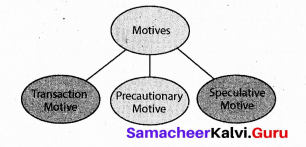
![]()
Question 43.
(a) Write a short note on Total Revenue.
Answer:
Total revenue is the amount of income received by the firm from the sale of its products. It is obtained by multiplying the price of the commodity by the number of units sold.
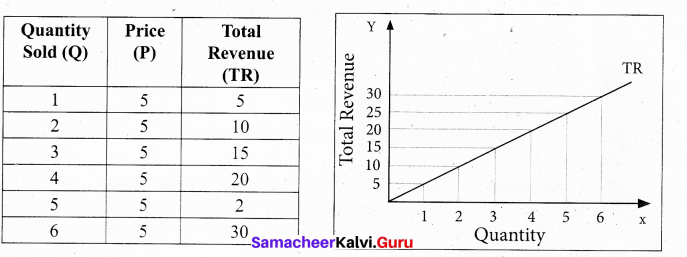
TR = P x Q
where, TR denotes Total Revenue, P denotes Price and Q denotes Quantity sold.
For example, a cell-phone company sold 100 cell-phones at the price of ₹ 500 each.
TR is ₹ 50,000.
(TR = 500 × 100 = 50,000).
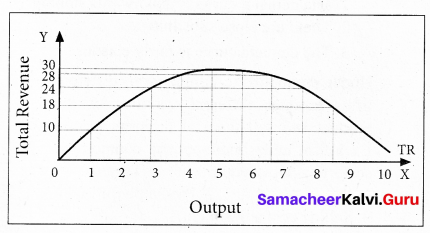
When price is constant, the behaviour of TR is shown in the above table and diagram, assuming P = 5.
When P = 5; TR = PQ
When price is declining with increase in quantity sold. (e.g. Imperfect Competition on the goods market) the behaviour of TR is shown in the following table and diagram. TR can be
obtained from Demand function : If Q = 11 – p, when P = 1 Q = 10
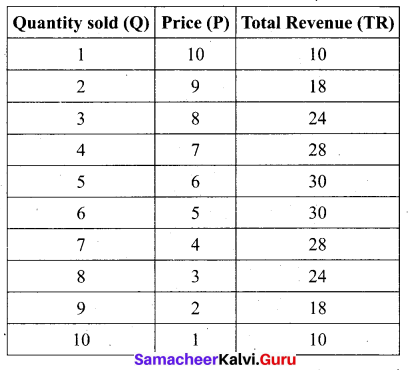
TR = PQ = 1 x 10= 10
When P = 3, Q = 8, TR = 24
When P = 0, Q = 1, TR = 10
[OR]
(b) Explain price and output determined under monopolistic competition with help of diagram.
Answer:
Price and output Determination under Monopolistic competition:
The firm under monopolistic competition achieves its equilibrium when it’s MC = MR, and when its MC curve cuts its MR curve from below. If MC is less than MR, the sellers will find it profitable to expand their output.
Under Monopolistic Competition:
- The demand curve is downwards sloping.
- There are close substitutes.
- The demand curve is fairly elastic.
Under monopolistic competition, different firms produce different varieties of the product and sell them at different prices.
Each firm under monopolistic competition seeks to achieve equilibrium as regards.
- Price and output
- Product adjustment
- Selling cost adjustment.
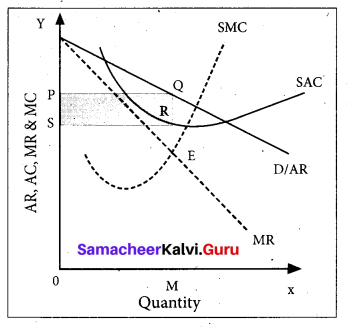
Short-run equilibrium:
The profit maximisation is achieved when MC = MR.
‘OM’ is the equilibrium output. ‘OP’ is the equilibrium price. The total revenue is ‘OMQP’. And the total cost is ‘OMRS’.
Therefore, total profit is ‘PQRS’. This is super normal profit under short-run. But under differing revenue and cost conditions, the monopolistically competitive firms many incur loss.
As shown in the diagram, the AR and MR curves are fairly elastic. The equilibrium situation occurs at point ‘E’,
where MC = MR
and MC cuts MR from below.
The equilibrium output is OM and the equilibrium price is OR The total revenue of the firm is ‘OMQP’ and the total cost of the firm is ‘OMLK’ and thus the total loss is ‘PQLK’. This firm incurs loss in the short run.
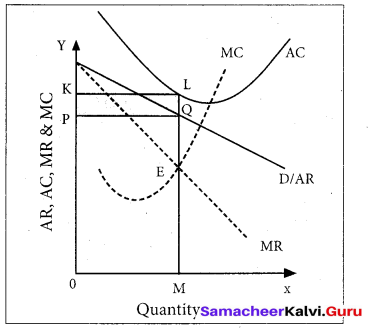
Long-Run Equilibrium of the Firm and the Group Equilibrium.
In the short run a firm under monopolistic competition may earn super normal profit or incur loss. But in the long run, the entry of the new firms in the industry will wipe out the super normal profit earned by the existing firms. The entry of new firms and exit of loss making firms will result in normal profit for the firms in the industry.
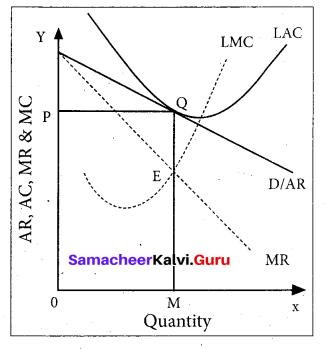
In the long run AR curve is more elastic or flatter, because plenty’ of substitutes are available.
Hence, the firms will earn only normal profit.
![]()
Question 44.
(a) State the Cobb – Douglas production function.
Answer:
The Cobb-Douglas Production Function was developed by Charles W. Cobb and Paul H. Douglas, based on their empirical study of American manufacturing industry’. It is a linear homogeneous production function which implies that the factors of production can be substituted for one another up to a certain extent only.
The Cobb-Douglas production function can be expressed as follows.
Q = ALαKβ
Where, Q = output; A = positive constant; K = capital; L = Labor a and (3 are positive fractions showing, the elasticity coefficients of outputs for the inputs labor and capital, respectively.
β = (1 – α) since α + β = 1. denoting constant returns to scale.
Factor intensity can be measured by the ratio β / α.
The sum of α + β shows the returns to scale.
(i) (α + β) = 1, constant returns to scale. ‘
(ii) (α + β) < 1, diminishing returns to scale. (iii) (α + β) > 1, increasing returns to scale.
- The production function explains that with the proportionate increase in the factors, the output also increases in the same proportion.
- Cobb-Douglas production function implies constant returns to scale.
- Cobb-Douglas Production Function is a specific standard equation applied to describe how much output can be made with capital and labour inputs.
[OR]
(b) Bring out Jawaharlal Nehru’s contribution to the idea of economic development.
Answer:
Assumptions of Simple Income Determination:
- Jawaharlal Nehru, one of the chief builders of Modem India, was the first Prime Minister of Independent India.
- He was a great patriot, thinker and statesman.
(i) Democracy and Secularism:
- Jawaharlal Nehru was a firm believer in democracy.
- He believed in free speech civil liberty, adult franchise and the Rule of Law and Parliamentary democracy.
- Secularism, is another signal contribution of Nehru to India.
(ii) Planning:
- Jawaharlal Nehru was responsible for the introduction of planning in our country.
- Jawaharlal Nehru, the Plan was essentially an integrated approach for development.
- Nehru Spoke on the theme of planning.
- He said “the essence of planning is to find the best way to utilize all resources of manpower, of money and so on”.
- “Planning for Nehru was essentially linked up with Industrialization and eventual self-reliance for the country’s economic growth on an self-accelerating growth.
- Nehru carried through this basis strategy of planned development.
- Nehru’s contribution to the advancement of science, research, technology and industrial development cannot be forgotten.
- It was during is period, many IITs and Research Institutions were established.
- Nehru always in insited on “ scientific temper”.
Question 45.
(a) Discuss about the Indian economy during British Period.
Answer:
Indian Economy during the British period:
- India’s sea route trade to Europe started only after the arrival of Vascoda Gama in Calicut, India on May 20, 1498.
- The Portuguese had traded in Goa as early as 1510.
- In 1601 the East India Company was chartered, and the English began their first inroads into the Indian ocean.
- In 1614 Sir Thomas Roe was successful in getting permission from Jahangir for setting up factories and slowly moved all parts of India.
- Hundred years after Battle of Plassey, the rule ofthe East India Company finally did come to an end.
- In 1858, British Parliament passed a law through which the power for governance of India was transferred from the East India Company [EIC] to the British Crown.
- Even the transfer of power from the East India Company to the British Crown did not materially alter the situation.
- Britain had exploited India over a period of two centuries of its colonial rule.
- On the basis of the form of colonial exploitation, economic historians have divided the whole period into three phases:
- The period of merchant Capital
- The period of Industrial Capital
- The period of Finance Capital
[OR]
(b) Describe the Achievement of the Green Revolution.
Answer:
Achievement of the Green Revolution:
- The major achievement of the new strategy was to boost the production of major cereals viz., wheat and rice.
- The Green Revolution was confined only to High Yielding Varieties [HYV] cereals, mainly rice, wheat, maize and jowar.
- This strategy was mainly directed to increase the production of commercial crops or cash crops such as sugarcane, cotton, jute oilseeds and potatoes.
- Per hectare productivity of all crops had increased due to better seeds.
- Green Revolution had positive effect on development of Industries, which manufactured agricultural tools like tractors, engines, threshers and pumping sets.
- Green Revolution had bought prosperity to rural people.
- Increased production had generated employment opportunities for rural masses.
- Due to multiple cropping and more use of chemical fertilizers, the demand for labour increased.
- Financial resources were provided by banks and co-operative societies.
- These banks provided loans to farmer on easy terms.
![]()
Question 46.
(a) Explain the “Abolition of MRTP Act”.
Answer:
- The New Industrial policy of 1991 has abolished the Monopoly and Restrictive Trade Practices Act 1969.
- In 2010, the competition commission has emerged as the watchdog in monitoring competitive practices in the economy.
- The policy caused big changes including emergence of a strong and competitive private sector and a sizable number of foreign companies in India.
[OR]
(b) What are the limitations of “LPG”.
Answer:
Liberalization measures, when effectively enforced, favour an unrestricted entry offoreign companies in the domestic economy. Such an entry prevents the growth of the local manufacturers.
Privatization measures favour the continuance of the monopoly power. Only the powerful people can sustain in business markets. Social justice cannot be easily established and maintained. As a result, the disparities tend to widen among people and among regions.
As globalization measures tend to integrate all economies of the world and bringing them all under one umbrella; they pave the way for redistribution of economic power at the world level. Only the already well developed countries are favoured in this process and the welfare of the less developed countries will be neglected. The economic crisis of the developed countries are easily spread to the developing economies through trade.
![]()
Question 47.
(a) Compare and contrast various definitions of economics.
Answer:
1. Adam Smith’s wealth definition:
- Adam Smith [1723-1790] in his book “An Inquiry into Nature and Cause of Wealth of ‘ Nations” [ 1776] \ defines “Economics as the science of wealth”
- He-explains how a nation’s wealth is created and increased.
- He considers that the individual in the society wants to promote his own gain and in this process, he is guided and led by an “invisible hand”
- Adam Smith favours the introduction of “division of labour” to increase the quantum of output.
- Severe competition in factories and society helps in bettering the product.
- Supply force is very active and a commodity is made available to the consumers at the •lowest price.
2. Alfred Marshall welfare definition:
- Alfred Marshall [1842-1924] in his book “Principles of Economics” [1890] defines economics thus “Political Economy” or Economics is a study of mankind in the ordinary business of life.
- It examines that part of individual and social action which is most closely connected with the attainment and with the use of the material requisites of well being.
- Thus , it is on one side a study of wealth and on the other and more important side, a part of the study of man”.
The important features of Marshall’s definition are:
- Economics does not treat wealth as the be-all and end-all of economic activities.
- Man promotes primarily welfare and not wealth.
- The science of economics contains the concerns of ordinary people who are moved by love and not merely guided or directed by the desire to get maximum monetary benefit.
- Economics is a social science. It studies people in the society who influence one another.
3. Lionel Robbins – Scarcity definition:
- Lionel Robbins published a book “An Essay on the Nature and Significance of Economic Science” in 1932.
- According to him, “Economics is a science which studies human behaviour as a relationship between ends and scarce means which have alternative uses”.
The major features of Robbins’ definition:
- Ends refer to human wants, human beings have unlimited number of wants.
- On the other hand, resources or means that go to satisfy the unlimited human wants are
limited or scarce in supply. - The scarce means are capable of having alternative uses.
- An individual grades his wants and satisfies first his most urgent want.
- Economics, according to Robbins, is a science of choice.
4. Samuelson’s -growth definition:
Paul Samuelson defines economics as “the study of how men and society choose, with or without the use of money, to employ scarce productive resources which could have alternative uses to produce various commodities over time, and distribute them for consumption, now and in the future among various people and groups of society”.
The major implications of this definition are as follows:
- Samuelson’s makes his definition dynamic by including the element of time in it.
- Samuelson’s definition is applicable also in a barter economy.
- His definition covers various aspects like production, distribution and consumption.
- Samuelson treats economics as a social science.
- Samuelson appears to be the most satisfactory.
![]()
[OR]
(b) Explain the law of Equi-marginal utility.
Answer:
The law of the Equi-marginal utility:
- The law of diminishing marginal utility is applicable only to the want of a single commodity.
- The law of equi – marginal utility explains the behavior of a consumer when he consumer more than one commodity.
- Wants are unlimited but the income which is available are limited.
- This law explains how the consumer spends his limited income on various commodities to get maximum satisfaction.
- Law of Equi – Marginal Utility is also known as the law of substitution.
- “The law of consumer’s equilibrium ”
- “Gossen’s second law ” and “ The law of maximum satisfaction”.
Definition:
Marshall states the law as ,“ If a person has a thing which he can put to several uses, he will distribute it among these uses in such a way that it has the same marginal utility in all. For, if it had a greater marginal utility in one use than another he would gain by taking away some of it from the second use and applying it to first”.
Assumption:
- The consumer is rational in the sense that he wants to get maximum satisfaction.
- The utility of each commodity is measurable in cardinal numbers.
- The marginal utility of money remains constant. . .
- The income of the consumer is given.
- There is perfect competition in the market.
- The prices of the commodities are given.
- The law of diminishing marginal utility operates.
Illustration:
This law can be illustrated with the help of table. Let us assume that the consumer has a given income of ₹ 11. He wants to spend this entire income i.e. ₹ 11] on Apple and Orange. The price of an Apple and the price of an orange is ₹ 1 each.
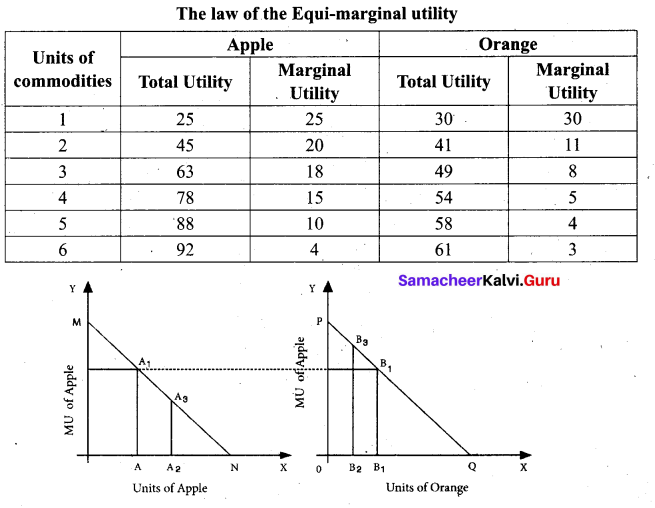
If the consumer wants to attain maximum utility, he should buy 6 units of apples and 5 units of oranges, so that she can get [92 + 58] = 150 units. No other combination of Apple and Orange can give higher than 150 utilities.
Diagrammatic Illustration:
- In the diagram, X – axis represents the amount of money spent and Y axis represents the marginal utilities of Apple and Orange respectively.
- If the consumer spends ₹ 6 on Apple and ₹ 5 on Orange, the marginal utilities of both are equal, i.e. AA1 = BB1 [4 = 4], Hence, he gets maximum utility.
Criticisms:
- In practice, utility cannot be measured, only be felt.
- This law cannot be applied to durable goods.